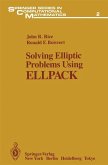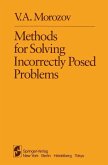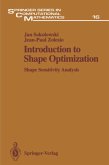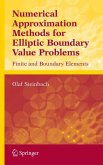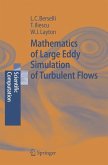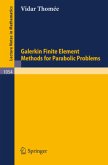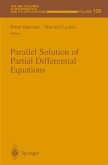- Gebundenes Buch
- Merkliste
- Auf die Merkliste
- Bewerten Bewerten
- Teilen
- Produkt teilen
- Produkterinnerung
- Produkterinnerung
ELLP ACK is a many faceted system for solving elliptic partial differential equations. It is a forerunner of the very high level, problem solving environments or expert systems that will become common in the next decade. While it is still far removed from the goals of the future, it is also far advanced compared to the Fortran library approach in common current use. Many people will find ELLP ACK an easy way to solve simple or moderately complex elliptic problems. Others will be able to solve really hard problems by digging a little deeper into ELLP ACK. ELLP ACK is a research tool for the…mehr
Andere Kunden interessierten sich auch für
![Solving Elliptic Problems Using ELLPACK Solving Elliptic Problems Using ELLPACK]() John R. RiceSolving Elliptic Problems Using ELLPACK39,99 €
John R. RiceSolving Elliptic Problems Using ELLPACK39,99 €![Methods for Solving Incorrectly Posed Problems Methods for Solving Incorrectly Posed Problems]() V. A. MorozovMethods for Solving Incorrectly Posed Problems39,99 €
V. A. MorozovMethods for Solving Incorrectly Posed Problems39,99 €![Introduction to Shape Optimization Introduction to Shape Optimization]() Jan SokolowskiIntroduction to Shape Optimization58,99 €
Jan SokolowskiIntroduction to Shape Optimization58,99 €![Numerical Approximation Methods for Elliptic Boundary Value Problems Numerical Approximation Methods for Elliptic Boundary Value Problems]() Olaf SteinbachNumerical Approximation Methods for Elliptic Boundary Value Problems38,99 €
Olaf SteinbachNumerical Approximation Methods for Elliptic Boundary Value Problems38,99 €![Mathematics of Large Eddy Simulation of Turbulent Flows Mathematics of Large Eddy Simulation of Turbulent Flows]() Luigi Carlo BerselliMathematics of Large Eddy Simulation of Turbulent Flows75,99 €
Luigi Carlo BerselliMathematics of Large Eddy Simulation of Turbulent Flows75,99 €![Galerkin Finite Element Methods for Parabolic Problems Galerkin Finite Element Methods for Parabolic Problems]() V. ThomeeGalerkin Finite Element Methods for Parabolic Problems39,99 €
V. ThomeeGalerkin Finite Element Methods for Parabolic Problems39,99 €![Parallel Solution of Partial Differential Equations Parallel Solution of Partial Differential Equations]() Parallel Solution of Partial Differential Equations38,99 €
Parallel Solution of Partial Differential Equations38,99 €-
-
ELLP ACK is a many faceted system for solving elliptic partial differential equations. It is a forerunner of the very high level, problem solving environments or expert systems that will become common in the next decade. While it is still far removed from the goals of the future, it is also far advanced compared to the Fortran library approach in common current use. Many people will find ELLP ACK an easy way to solve simple or moderately complex elliptic problems. Others will be able to solve really hard problems by digging a little deeper into ELLP ACK. ELLP ACK is a research tool for the study of numerical methods for solving elliptic problems. Its original purpose was for the evaluation and comparison of numerical software for elliptic problems. Simple examples of this use are given in Chapters 9-11. The general conclusion is that there are many ways to solve most elliptic problems, there are large differences in their efficiency and the most common ways are often less efficient, sometimes dramatically so.
Produktdetails
- Produktdetails
- Springer Series in Computational Mathematics .2
- Verlag: Springer, Berlin
- 1985.
- Seitenzahl: 497
- Englisch
- Abmessung: 242mm x 162mm x 30mm
- Gewicht: 895g
- ISBN-13: 9780387909103
- ISBN-10: 0387909109
- Artikelnr.: 24535250
- Herstellerkennzeichnung Die Herstellerinformationen sind derzeit nicht verfügbar.
- Springer Series in Computational Mathematics .2
- Verlag: Springer, Berlin
- 1985.
- Seitenzahl: 497
- Englisch
- Abmessung: 242mm x 162mm x 30mm
- Gewicht: 895g
- ISBN-13: 9780387909103
- ISBN-10: 0387909109
- Artikelnr.: 24535250
- Herstellerkennzeichnung Die Herstellerinformationen sind derzeit nicht verfügbar.
1: The ELLPACK System.- 1. Introduction.- A. Mathematical Preliminaries.- B. Numerical Methods Preliminaries.- C. The ELLPACK Project.- D. Brief Description of ELLPACK.- E. A Simple Program.- F. Organization of the Book.- G. References.- 2. The ELLPACK Language.- A. Organization of an ELLPACK Program.- B. Segments which Define the Problem.- C. The GRID Segment.- D. Segments which Specify the Numerical Methods.- E. Fortran and Program Control.- F. OUTPUT and OPTIONS Segments.- G. Debugging ELLPACK Programs.- H. References.- 3. Examples.- A. Example of Chapter 1 Revised.- B. General Equation with Mixed Boundary Conditions.- C. How Fortran and ELLPACK Interact.- 4. Advanced ELLPACK Features.- A. Additional Segments.- B. Additional Features of Basic Segments.- C. Access to Preprocessor Variables.- D. Advanced ELLPACK Examples.- E. References.- 5. Extending ELLPACK to Nonstandard Problems.- A. Special Interior Boundary Conditions.- B. Two-Phase Diffusion Problem.- C. Newton Iteration for Nonlinear Problems.- D. Time Dependent Problem.- E. Systems of Elliptic Problems.- F. References.- 2: The ELLPACK Modules.- 6. The ELLPACK Modules.- A. Introduction.- B. Description of the Modules.- C. The Modules.- 7. ITPACK Solution Modules.- A. ITPACK Iterative Algorithms.- B. ITPACK Modules.- C. ITPACK Project.- D. References.- 3: Performance Evaluation.- 8. Performance and its Evaluation.- A. Measures of Performance.- B. Analytical Evaluation of Performance.- C. Experimental Evaluation of Performance.- 9. The Model Problems.- 10. Performance of Discretization Modules.- A. Poisson Problem.- B. Helmholtz Problem.- C. Boundary Layer Problem.- D. General Elliptic Operator.- E. General, Difficult Elliptic Problem.- F. Mixed Boundary Conditions.- G. Singular Problem.- H. Nonrectangular Domain.- I. Three Dimensional Poisson Problem.- 11. Performance of Solution Modules.- A. Solution of the 5-Point Star Equations.- B. Solution of the HODIE-Helmholtz Equations.- C. Solution of the Collocation Equations.- D. Solution of the Galerkin Equations.- E. Solution of the 7 Point 3D Equations.- F. References.- 4: Contributor's Guide.- 12. Software Parts for Elliptic Problems.- A. Overview.- B. Contributor's checklist.- C. Conventions.- D. References.- 13. Interface Specifications.- A. Problem interface.- B. Discretized domain interface.- C. Discretized PDE Interface.- D. Equation/unknown indexing interface.- E. Algebraic equation solution interface.- F. Triple and procedure modules.- G. Solution evaluation.- H. Control variables.- 14. Module Interface Access.- A. Storage Scheme for Interface Variables.- B. Module-Parameter Access.- C. Workspace Access.- 15. Programming Standards.- A. Printed Output.- B. Error Handling.- C. Portability.- D. Documentation.- E. Utility Programs.- F. References.- 16. Preprocessor Data.- A. Introduction to the Preprocessor.- B. The ELLPACK Definition File.- C. Examples of File Entries.- D. Conditional Code Generation.- 5: System Programming Guide.- 17. Installing ELLPACK.- A. Overview of the System.- B. Installation Procedure Summary.- C. The ELLPACK Tape.- D. Preparing the ELLPACK Modules.- E. Preparing the ELLPACK Preprocessor.- F. Sample control card procedures.- G. References.- 18. Tailoring ELLPACK.- A. Organization of the Preprocessor.- B. Organization of the ELLPACK Control Program.- C. How to Add Modules to ELLPACK.- D. How to Change the ELLPACK Language.- Appendices.- A. The PDE Population by W. R. Dyksen, E. N. Houstis and J. R. Rice.- 1. Introduction.- 2. Characteristics of the Problems.- 3. Format of PDE Problem Descriptions.- 4. Acknowledgements.- 5. Problem Definitions and Plots.- 6. Sources of Problems.- 7. References.- The PG (Preprocessor Generator) System by J. F. Brophy.- 1. Introduction to PG Grammars.- 2. PG Rule Syntax.- 3. PG Actions.- 4. Special Segments.- 5. PG Internals.- 6. Installing PG.- 7. Acknowledgements.- 8. References.- The Template Processor by J. R. Rice, C. J. Ribbens and W. A. Ward.- 1. Introduc
1: The ELLPACK System.- 1. Introduction.- A. Mathematical Preliminaries.- B. Numerical Methods Preliminaries.- C. The ELLPACK Project.- D. Brief Description of ELLPACK.- E. A Simple Program.- F. Organization of the Book.- G. References.- 2. The ELLPACK Language.- A. Organization of an ELLPACK Program.- B. Segments which Define the Problem.- C. The GRID Segment.- D. Segments which Specify the Numerical Methods.- E. Fortran and Program Control.- F. OUTPUT and OPTIONS Segments.- G. Debugging ELLPACK Programs.- H. References.- 3. Examples.- A. Example of Chapter 1 Revised.- B. General Equation with Mixed Boundary Conditions.- C. How Fortran and ELLPACK Interact.- 4. Advanced ELLPACK Features.- A. Additional Segments.- B. Additional Features of Basic Segments.- C. Access to Preprocessor Variables.- D. Advanced ELLPACK Examples.- E. References.- 5. Extending ELLPACK to Nonstandard Problems.- A. Special Interior Boundary Conditions.- B. Two-Phase Diffusion Problem.- C. Newton Iteration for Nonlinear Problems.- D. Time Dependent Problem.- E. Systems of Elliptic Problems.- F. References.- 2: The ELLPACK Modules.- 6. The ELLPACK Modules.- A. Introduction.- B. Description of the Modules.- C. The Modules.- 7. ITPACK Solution Modules.- A. ITPACK Iterative Algorithms.- B. ITPACK Modules.- C. ITPACK Project.- D. References.- 3: Performance Evaluation.- 8. Performance and its Evaluation.- A. Measures of Performance.- B. Analytical Evaluation of Performance.- C. Experimental Evaluation of Performance.- 9. The Model Problems.- 10. Performance of Discretization Modules.- A. Poisson Problem.- B. Helmholtz Problem.- C. Boundary Layer Problem.- D. General Elliptic Operator.- E. General, Difficult Elliptic Problem.- F. Mixed Boundary Conditions.- G. Singular Problem.- H. Nonrectangular Domain.- I. Three Dimensional Poisson Problem.- 11. Performance of Solution Modules.- A. Solution of the 5-Point Star Equations.- B. Solution of the HODIE-Helmholtz Equations.- C. Solution of the Collocation Equations.- D. Solution of the Galerkin Equations.- E. Solution of the 7 Point 3D Equations.- F. References.- 4: Contributor's Guide.- 12. Software Parts for Elliptic Problems.- A. Overview.- B. Contributor's checklist.- C. Conventions.- D. References.- 13. Interface Specifications.- A. Problem interface.- B. Discretized domain interface.- C. Discretized PDE Interface.- D. Equation/unknown indexing interface.- E. Algebraic equation solution interface.- F. Triple and procedure modules.- G. Solution evaluation.- H. Control variables.- 14. Module Interface Access.- A. Storage Scheme for Interface Variables.- B. Module-Parameter Access.- C. Workspace Access.- 15. Programming Standards.- A. Printed Output.- B. Error Handling.- C. Portability.- D. Documentation.- E. Utility Programs.- F. References.- 16. Preprocessor Data.- A. Introduction to the Preprocessor.- B. The ELLPACK Definition File.- C. Examples of File Entries.- D. Conditional Code Generation.- 5: System Programming Guide.- 17. Installing ELLPACK.- A. Overview of the System.- B. Installation Procedure Summary.- C. The ELLPACK Tape.- D. Preparing the ELLPACK Modules.- E. Preparing the ELLPACK Preprocessor.- F. Sample control card procedures.- G. References.- 18. Tailoring ELLPACK.- A. Organization of the Preprocessor.- B. Organization of the ELLPACK Control Program.- C. How to Add Modules to ELLPACK.- D. How to Change the ELLPACK Language.- Appendices.- A. The PDE Population by W. R. Dyksen, E. N. Houstis and J. R. Rice.- 1. Introduction.- 2. Characteristics of the Problems.- 3. Format of PDE Problem Descriptions.- 4. Acknowledgements.- 5. Problem Definitions and Plots.- 6. Sources of Problems.- 7. References.- The PG (Preprocessor Generator) System by J. F. Brophy.- 1. Introduction to PG Grammars.- 2. PG Rule Syntax.- 3. PG Actions.- 4. Special Segments.- 5. PG Internals.- 6. Installing PG.- 7. Acknowledgements.- 8. References.- The Template Processor by J. R. Rice, C. J. Ribbens and W. A. Ward.- 1. Introduc


